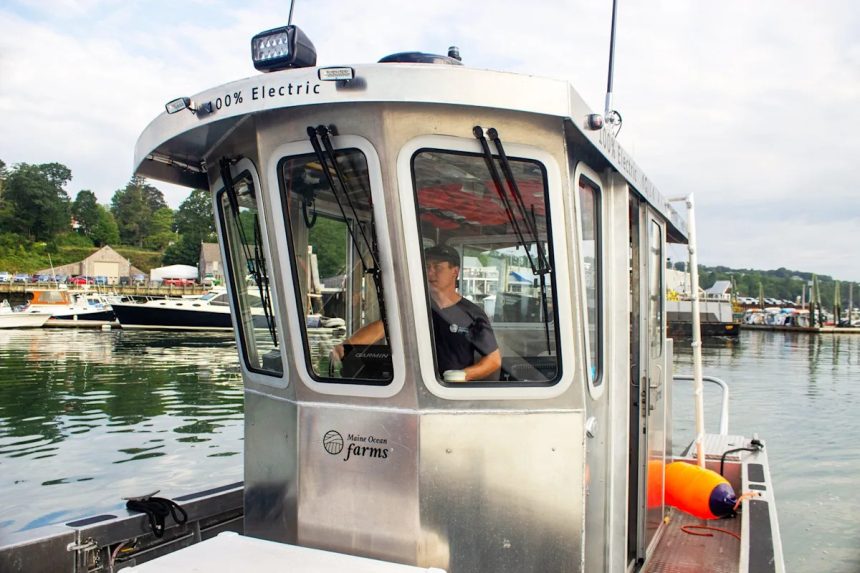This article was copublished with The Daily Yonder, a newsroom covering rural America.
YARMOUTH, Maine — At a dock along the banks of the Cousins River, Chad Strater loaded up his small aluminum workboat with power tools and a winch. Strater, who owns a marine construction business, was setting out to tinker with floating equipment at a nearby oyster farm. On the quiet morning in August, with the sun already beating down hard, his vessel whirred to life, only without the usual growl of an oil-guzzling motor. The boat is all electric.
Just north of where the Cousins River meets Casco Bay, Willy Leathers was powering up his own electric watercraft, which had its first outing in July. Leathers uses his 28-foot boat for cultivating oysters at Maine Ocean Farms, where roughly 3 million of the animals grow in dozens of floating cages.
Both Strater and Leathers said they switched to electric workboats for several reasons. Their new watercraft are a cleaner alternative to the smelly, polluting petroleum-powered vessels that dominate Maine’s 3,500 miles of coastline. Electric propulsion is also significantly quieter than a gas or diesel motor. For Leathers, whose 10-acre sea farm is a significant presence in the cove where he operates, the swap is about being a good neighbor to the shoreside community.
“It’s an innovation born from necessity for us,” said Strater about his electric boat, which he docks each night at the Sea Meadow Marine Foundation, the nonprofit boatyard and aquaculture innovation hub he runs with several other small business owners. “[The boat] really works well for what we do with it, and we’re letting farmers use it to see how it could work for them.”
Battery-powered vessels are starting to catch on in the United States and worldwide as companies and maritime authorities work to reduce emissions and improve the experience of cruising waterways. The technology ranges from small outboard motors on workboats and recreational watercraft to powerful inboard systems on ferries, tugboats, and supply vessels for offshore wind farms and oil rigs.
In recent decades, Norway, with its extensive coastline and ample government funding, has spearheaded the transition globally. China, which is both the world’s largest shipbuilder and battery manufacturer, has rapidly deployed hundreds of battery-powered vessels over the last several years. Falling battery costs, better technology, and stricter environmental rules are compelling some vessel owners to install partial or fully electric systems, primarily for watercraft that operate near the shore or on fixed routes. For commercial fishing in particular, customers are helping to drive the push to clean up.
“Everyone’s more concerned now with where their food comes from, and we’ve seen that [consumers] are looking for that complete sustainable supply chain,” said Ed Schwarz, the head of marine solutions sales in North America for Siemens Energy, which has built electric propulsion systems for U.S. ferries.
Electrification has only very recently come to America’s aquaculture sector. In Maine, the small but fast-growing segment includes nearly 200 farms for shellfish, fin fish, and edible seaweed. Strater and Leathers are among the first in their business to trade gas motors for electric propulsion — a switch they say they’re hoping to accelerate. Oil-guzzling motors are among the largest sources of greenhouse gas emissions for the state’s multibillion-dollar seafood sector.
Still, electrifying commercial watercraft can be a difficult course to navigate, given the higher up-front costs of electric motors and the lack of charging infrastructure — and grid infrastructure in general — in rural waterfront communities.
Early adopters like Strater and Leathers said they hope the experiences gained from their demonstrations can help pave the way for decarbonizing Maine’s blue economy. With the help of the Island Institute, a Maine-based nonprofit that works on marine-related energy transitions, Leathers is collecting performance data from his vessel to share more broadly with the industry.
“People say it looks cool and shiny and looks like it operates great,” Lia Morris, the Island Institute’s senior community development officer, said of electric boats. “But we really want to be able to prove out the [business] case.”
Electric boats can cost between 20% and 30% more than a gas- or diesel-powered vessel of a comparable size. However, owners can save on maintenance and fuel over the long term, Strater’s business partner Nick Planson said.
“The high-level math that we’ve come up with” is a financial break-even point of “about four to five years, and then over a 10-year time span, you’re definitely coming out way ahead based on the vastly reduced maintenance cost, replacement cost of failed equipment, and fuel costs,” said Planson.
But the initial price tag presents a significant hurdle. Strater and Planson’s sleekly designed, no-frills watercraft cost $100,000 to build and outfit with a single electric outboard motor. Leathers’ boat, called Heron, cost about four times more. It has two electric outboards and a ramp for unloading and hauling more than 10,000 oysters at a time from the sea farm to distributors waiting on the dock. Its hull is also equipped with a small cabin and toilet.
Both operations relied on grant funding to defray the expense of going electric.
For their part, Strater and Planson used about $50,000 from a larger U.S. Department of Agriculture small business grant they got in 2024 to establish a use case for electric workboats in the aquaculture industry. Leathers’ business, Maine Ocean Farms, was included on a collaborative $500,000 U.S. Department of Energy grant last year that earmarked about $289,000 for boat building and propulsion systems, in addition to other funds for charging infrastructure and data collection.
The prospects for funding future projects are now much murkier under the Trump administration, maritime policy experts say.
The DOE’s Office of Energy Efficiency and Renewable Energy, which awarded the money to Maine Ocean Farms and its partners, is facing significant budget cuts in the next fiscal year. The GOP-backed spending law that passed in July rescinded some unobligated grant funding for cleaning up marine diesel engines. While other programs were spared, it’s unclear whether the current Congress will approve new funding for initiatives ranging from electrifying huge urban ports to deploying low-emissions ferries in rural communities.
But federal grants aren’t the only way to address the higher cost of electric boats. Strater and Planson also worked with Coastal Enterprises Inc., a Maine-based community development financial institution focused on climate resilience, to establish a “marine green” loan program that can make the up-front costs of switching to electric propulsion more accessible to small businesses.
“The more electric engines that are being employed in Maine helps lift the whole tide for everyone,” said Nick Branchina, director of CEI’s fisheries and aquaculture program. As part of its marine green lending, CEI offers loans starting at $25,000 for small businesses to make the switch to electric propulsion and comfortably afford the cost of batteries or a shoreside charging installation.
Planson said that as electrification moves beyond initial grant-funded projects, the challenge is keeping systems affordable. He said he wants to see other small business owners able to “take a reasonable swing” at electric propulsion.
Buying a boat, of course, is only the first obstacle. Electric vessel owners must also learn how to use their new propulsion systems and find a place to charge them.
This summer, Leathers said he’s had no trouble making the nearly two-mile round trip from the slip where he docks Heron in South Freeport, Maine, to his farm on Casco Bay. With a full charge, he can make trips slightly farther to meet distributors closer to Portland. But as temperatures drop this winter, Leathers said he’s not sure how far the outboards’ two batteries will take him. Cold weather can reduce battery capacity and impact performance, shrinking an electric motor’s range. It’s a part of Leathers’ demonstration to find out what the impacts are in practice.
Like Leathers, Strater and Planson also work year-round. They said they’re both impressed with how their boat performed last winter after launching in the fall of 2024. For Planson, who markets battery-powered equipment to aquaculture farmers as part of his startup, Shred Electric, a boat’s ability to run through the year’s coldest months is a key selling point.
“The proof is in the pudding,” said Planson. “When you’re working with … waterfront applications, it really needs to work every day and all year.”
Strater and Planson said their boat’s range was an important consideration when they partnered with the startup Flux Marine to build the electric outboard motor. With limited shoreside charging infrastructure in place, the boat has to make it out and back on a single charge, sometimes to aquaculture operations seven miles away. In the 10 months since the boat’s launch, Strater has learned range correlates to speed. He can modulate the boat’s pace depending on how far he wants to go.
“We can go really fast for a short distance. We can go really slow for a long distance, and it works for what we do with it,” he said.
Soon, Maine’s early adopters will have shared access to a higher-capacity Level 2 charger that will be installed at the Sea Meadow Marine Foundation and can charge batteries in little over two hours, or three times faster than the current system. The startup Aqua superPower was awarded a portion of the DOE funding last year to install additional marine chargers there and at a wharf in Portland owned by the Gulf of Maine Research Institute. Island Institute also helped with grant funding for the charger at the Sea Meadow boatyard.
Maine will need much more high-capacity charging infrastructure for the marine industry to transition to electric propulsion, said the Island Institute’s Morris. As the state’s aquaculture and fisheries industries look to grow beyond small-scale operations, other businesses will need to charge more frequently to make longer, farther trips up and down the coast.
Expanding charging stations north of Casco Bay represents what Morris calls a “chicken and egg” problem: a dynamic where chargers are either installed before demand gets high, and sit unused, or electric boats hit the water and there’s not enough charging infrastructure, stalling future adoption.
This challenge is compounded by both New England’s aging grid infrastructure and the remote nature of some of the region’s waterfront access points. Getting the right amount of power to a charging station on the shore can be costly, even in Yarmouth, which sits on Casco Bay. Often it’s the last mile that can be the most expensive. At Sea Meadow Marine Foundation, three-phase power, which can accommodate higher loads, is limited by the dirt road that separates the boat launch from the more heavily trafficked U.S. Route 1.
“There are a lot of complicated questions,” Morris said. “I don’t think it’s unique to Maine, it’s any rural area, but complicated questions and conversations with the utilities and the rural municipalities are going to have to be solved for.”
Back on the water, Leathers docked his electric boat, Heron, alongside the sea farm’s barge, where thousands of oysters pass through for processing on harvest days. He switched the motor off and hopped onto the floating platform. For a moment, the bay was calm to the point of near silence. Then Leathers picked up an oyster cage with a rattle, turning it over in his hands as water splashed out. The sounds of the workday began.
“As a whole industry, I think it’s going to take proving that someone like us can do it,” Leathers said. “And then the next person kind of snowballing after that.”









